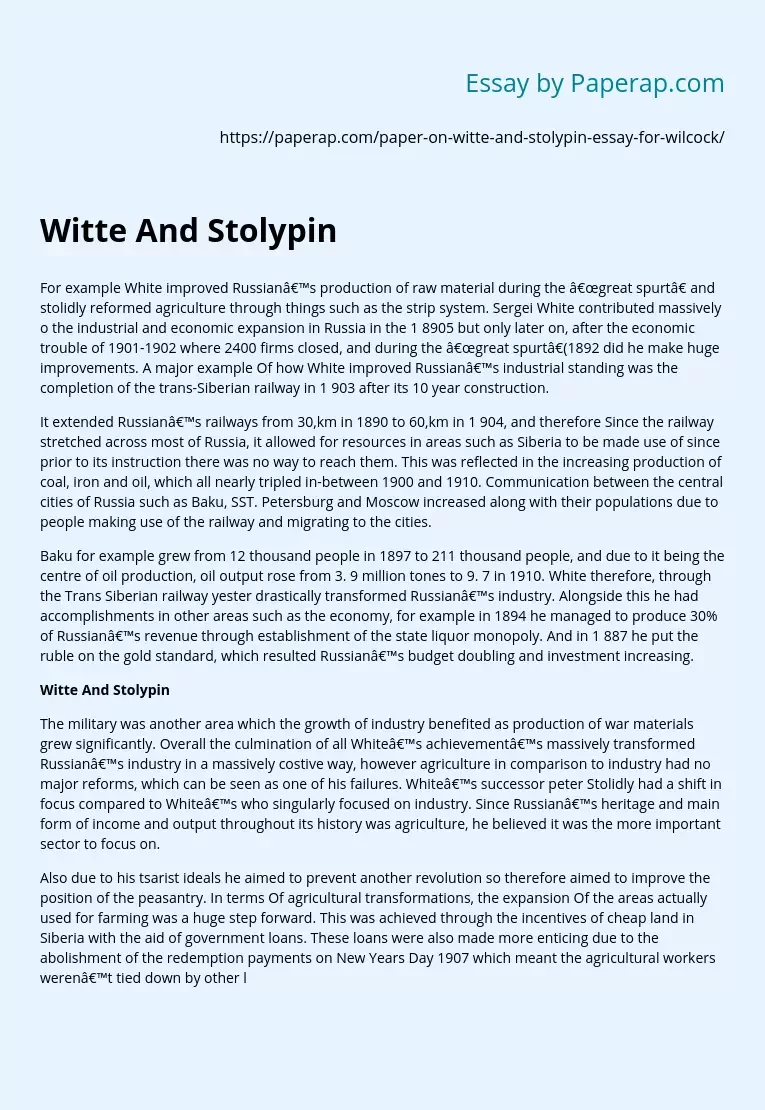Witte And Stolypin
For example White improved Russian’s production of raw material during the “great spurt” and stolidly reformed agriculture through things such as the strip system. Sergei White contributed massively o the industrial and economic expansion in Russia in the 1 8905 but only later on, after the economic trouble of 1901-1902 where 2400 firms closed, and during the “great spurt”(1892 did he make huge improvements. A major example Of how White improved Russian’s industrial standing was the completion of the trans-Siberian railway in 1 903 after its 10 year construction.
It extended Russian’s railways from 30,km in 1890 to 60,km in 1 904, and therefore Since the railway stretched across most of Russia, it allowed for resources in areas such as Siberia to be made use of since prior to its instruction there was no way to reach them. This was reflected in the increasing production of coal, iron and oil, which all nearly tripled in-between 1900 and 1910. Communication between the central cities of Russia such as Baku, SST.
Petersburg and Moscow increased along with their populations due to people making use of the railway and migrating to the cities.
Baku for example grew from 12 thousand people in 1897 to 211 thousand people, and due to it being the centre of oil production, oil output rose from 3. 9 million tones to 9. 7 in 1910. White therefore, through the Trans Siberian railway yester drastically transformed Russian’s industry. Alongside this he had accomplishments in other areas such as the economy, for example in 1894 he managed to produce 30% of Russian’s revenue through establishment of the state liquor monopoly.
And in 1 887 he put the ruble on the gold standard, which resulted Russian’s budget doubling and investment increasing.
Witte And Stolypin
The military was another area which the growth of industry benefited as production of war materials grew significantly. Overall the culmination of all White’s achievement’s massively transformed Russian’s industry in a massively costive way, however agriculture in comparison to industry had no major reforms, which can be seen as one of his failures. White’s successor peter Stolidly had a shift in focus compared to White’s who singularly focused on industry. Since Russian’s heritage and main form of income and output throughout its history was agriculture, he believed it was the more important sector to focus on.
Also due to his tsarist ideals he aimed to prevent another revolution so therefore aimed to improve the position of the peasantry. In terms Of agricultural transformations, the expansion Of the areas actually used for farming was a huge step forward. This was achieved through the incentives of cheap land in Siberia with the aid of government loans. These loans were also made more enticing due to the abolishment of the redemption payments on New Years Day 1907 which meant the agricultural workers weren’t tied down by other loans and payments. These reforms under Stolidly were considerably successful as in 1 906, agricultural production was 45. Million tones but by 1 91 3 it was 61. 7 million tones. The lives of those actually doing the work were also transformed due the peasants being freed from the commune under the law of 9 in November 906 and then financial aid was given in the form of the land bank after its creation on the 1 5th November 1906. Arguably one of Cytolysis’s most effective reforms was the strip system. Allowing for the equal distribution of land along with a more effective farming method agricultural production rose massively and peasant owning their own land increased from 20% to 50% in between 1905 and 1915.
The creation of the “kulaks” also improved agriculture since the new class of peasants were more hard working and motivated in comparison to their previous ways of being lazy and inefficient. Stolidly and his numerous reforms did undoubtedly transform Russian’s agriculture and improved upon its position in relation to agriculture before he took charge, however his reforms were cut short by the start of howl and Russian’s needs changed. However both Stolidly and White had drawback during their time as chief minister to the Tsar.
White focused solely on industry without any notable thought to Russian’s agricultural position, which is reflected in the slow increase in cereal production in-between 1 890 and 1900 of 36 million tones to 56 million tones in comparison to the tripling of industrial production in the same timeshare. Living conditions in the urban areas decreased rapidly during White’s mass arbitration as the crowds that flooded into the towns and cities after the railways completion had nowhere to go since it all occurred to fast for the cities to expand and be able to accommodate the increasing populous.
Also in relation to arbitration and industrial growth, everything he achieved, although it was a step forward for the previously backwards Russia, was far behind that of the western world. To support this it can be said that he did not transform industry and actually oaken it by urbanism to much since due to poor conditions, in some cases famine occurred which reduced Russian’s output as workers were not as effective.
Witte And Stolypin. (2019, Dec 05). Retrieved from https://paperap.com/paper-on-witte-and-stolypin-essay-for-wilcock/

